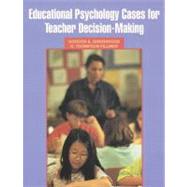| Introduction | 1 | (18) | |||
| Educational Psychology and Teaching | 1 | (1) | |||
| Case Studies and Teacher Education | 2 | (1) | |||
| Sample Case | 3 | (6) | |||
| Analyzing Cases | 9 | (1) | |||
| Sample Case Analysis and Decision | 10 | (5) | |||
| Critique of Sample Analysis and Decision | 15 | (2) | |||
| Organization of Cases | 17 | (2) | |||
| PART 1 INTRODUCTION TO EDUCATIONAL PSYCHOLOGY | 19 | (16) | |||
|
19 | (8) | |||
|
27 | (8) | |||
| PART 2 HUMAN DEVELOPMENT | 35 | (42) | |||
|
35 | (6) | |||
|
41 | (10) | |||
|
51 | (9) | |||
|
60 | (8) | |||
|
68 | (9) | |||
| PART 3 CULTURAL DIVERSITY | 77 | (40) | |||
|
77 | (11) | |||
|
88 | (10) | |||
|
98 | (10) | |||
|
108 | (9) | |||
| PART 4 LEARNING AND INSTRUCTION | 117 | (57) | |||
|
117 | (10) | |||
|
127 | (9) | |||
|
136 | (10) | |||
|
146 | (8) | |||
|
154 | (9) | |||
|
163 | (11) | |||
| PART 5 MOTIVATION AND CLASSROOM MANAGEMENT | 174 | (78) | |||
|
174 | (9) | |||
|
183 | (10) | |||
|
193 | (10) | |||
|
203 | (10) | |||
|
213 | (10) | |||
|
223 | (9) | |||
|
232 | (12) | |||
|
244 | (8) | |||
| PART 6 ASSESSMENT, EVALUATION, AND TEACHER EFFECTIVENESS | 252 | (43) | |||
|
252 | (9) | |||
|
261 | (8) | |||
|
269 | (9) | |||
|
278 | (10) | |||
|
288 | (7) | |||
| APPENDICES | 295 | ||||
| A Theory Guide | 295 | (3) | |||
| B Using Cases in College Teaching | 298 |








